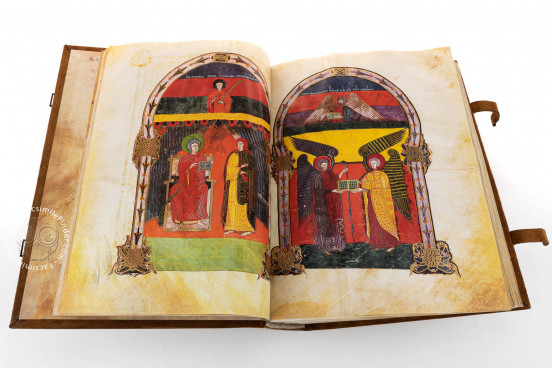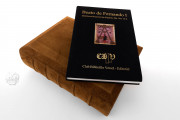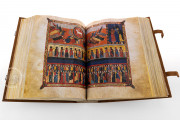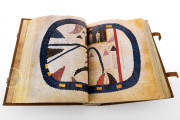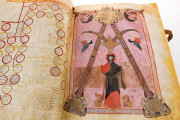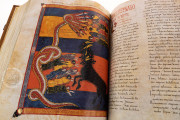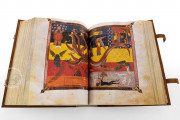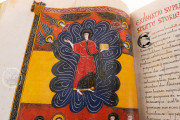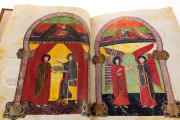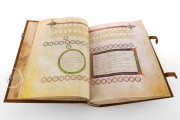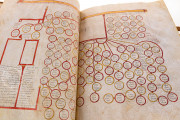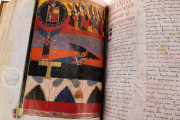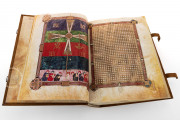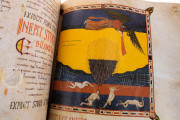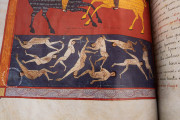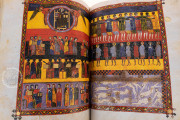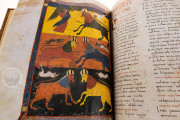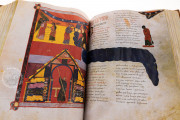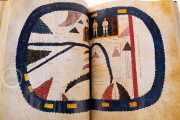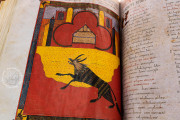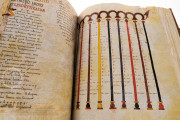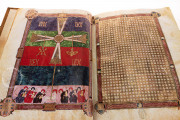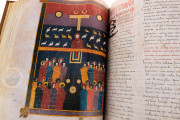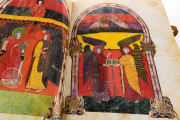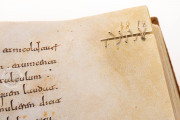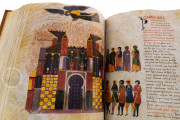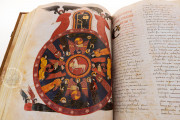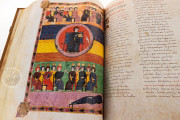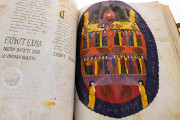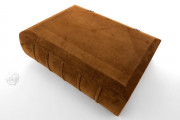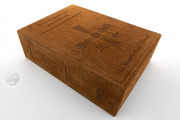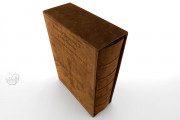The Facundus Codex is one of the most elegant and well-preserved manuscripts of Beatus of Liébana's commentary on the Christian biblical book of the Apocalypse. Named for its scribe, Facundus, it was probably created at the royal scriptorium of the Kingdom of León in 1047 for King Ferdinand I and his consort, Sancha. It is the only one of the surviving Spanish Beatus manuscripts demonstrably made for lay patrons. More than eighty of the manuscript's brightly colored miniatures illustrate the texts of the Apocalypse and the Old Testament prophecy of Daniel.
The painting of the prefatory miniatures is noteworthy for the liberal use of gold and silver along with red, yellow, deep purple, inky blue, green, violet, and black, and the figures are extremely finely drawn. The miniatures that illustrate the biblical text often present the events on backgrounds of horizontal bands of brilliant color.
Facundus, a Scribe and a Painter?
The illumination is the work of two artists. The more subtle of the two, who created sensitive, intricate interlace designs, painted all the prefatory images—including the genealogy of Christ—and seven of the Apocalypse and Daniel scenes. It is thought that he may have been the scribe Facundus. The second artist painted the lion's share (seventy-six) of the miniatures.
New Stylistic Features
The Facundus Beatus stands in an established tradition of illuminated manuscripts of the commentary on the Apocalypse by the eighth-century Spanish monk Beatus of Liébana. The earliest fragment dates from the last quarter of the ninth century, and eight more illuminated copies antedate the Facundus Codex, including the Tábara Codex and the Urgell Codex.
The miniatures of the Facundus Codex introduce two important stylistic developments. There is a new sense of the shape of the figures underneath the stylized drapery. The figures also seem to have weight and to stand on the ground—this despite the abstract color bands of the backgrounds—in contrast to the seeming weightless of the figures in the tenth-century manuscripts.
The Apocalypse Text Doubled
Beatus's text is presented as an alternation of excepts from the biblical text (each called a storia) with the Spanish monk's explanation of the excerpt. In the Facundus Codex, this text is preceded by the complete biblical text compiled from the storiae of the commentary, an unusual feature shared only with the later Osma Codex of 1086.
Facundus wrote his text in Visigothic Minuscule, the characteristic script of the Iberian peninsula from its introduction in the early eighth century until it was abandoned in the twelfth. Rubrics announcing the beginnings and ends of major sections of text are written in red in a display script of tall, thin letters.
Confiscated for the Royal Library
The manuscript was at the monastery of San Isidoro in León in the early modern period. By the end of the seventeenth century, it belonged to Gaspar Ibáñez de Segovia Peralta y Mendoza (1628-1708), Marqués de Mondéjar. It was confiscated for the Biblioteca Pública de Palacio, founded in 1711 by Philip V (1638-1746), King of Spain. The library was renamed the Biblioteca Nacional in 1836. The first five leaves of MS Vit. 14-2 may be from the tenth-century Valladolid Beatus.
_____
For more information on the Beatus model, read our blog article by Amy R. Miller (PhD, Medieval Art History, University of Toronto).
We have 2 facsimiles of the manuscript "Beatus of Liébana - Facundus Codex":
- Beato de Fernando I y Sancha facsimile edition published by Club Bibliófilo Versol, 2006
- Beato de Liébana, Códice de Fernando I y Doña Sancha facsimile edition published by M. Moleiro Editor, 1994

